These archive pages are provided in order to make it easier for you to find items
that you remember seeing on the Airplanes and Rockets homepage. Of course probably
the easiest way to find anything on the website is to use the "Search AAR" box at
the top of every page.
1 |
2 |
3 |
4 |
5 |
6 |
7 |
8 |
9 |
10 |
11 |
12 |
13 |
14 |
15 |
16 |
17 |
18 |
19 |
20
21 |
22 |
23 |
24 |
25 |
26 |
27 |
28 |
29 |
30 |
31 |
32 |
33 |
34 |
35 |
36 | 37
| 38 | 39
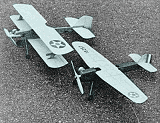 A lot of careful thought and detail went
into planning and rationalizing why a biplane version of the venerable
MO-1 control
line carrier model should fly better than the traditional monoplane platform.
It was January of 1973 when this article appeared in American Aircraft Modeler
magazine. Time has shown that the old adage about if something isn't broken, don't
fix it must ring true here. That is not to say efforts should not be undertaken
to improve on a design, just that in this case going to a biplane configuration
was not the answer. Maybe website visitor Duke J., who wrote to ask for this article,
can pick up where Mr. Gerber and Mr. Higley (yes, THE Harry Higley) left off. Maybe
a MO-Tripe...? A lot of careful thought and detail went
into planning and rationalizing why a biplane version of the venerable
MO-1 control
line carrier model should fly better than the traditional monoplane platform.
It was January of 1973 when this article appeared in American Aircraft Modeler
magazine. Time has shown that the old adage about if something isn't broken, don't
fix it must ring true here. That is not to say efforts should not be undertaken
to improve on a design, just that in this case going to a biplane configuration
was not the answer. Maybe website visitor Duke J., who wrote to ask for this article,
can pick up where Mr. Gerber and Mr. Higley (yes, THE Harry Higley) left off. Maybe
a MO-Tripe...?
 When this issue of Life magazine came out
in March of 1942, America was only a couple months past when the Imperial Japanese
Navy Air Service executed the surprise attack on Pearl Harbor shortly before Christmas
on a quiet Sunday morning. As with when a group of Muslim extremists attacked America
on September 11, 2001, the vast majority of the country pulled together and delivered
a significant response to the perpetrators. During Word War II, in order to
help train our troops recognize and differentiate between Allied aircraft and Axis
aircraft,
models were built at a scale which would fairly represent what the real thing
would look like in the sky at a distance that placed it within range of anti-aircraft
munitions. The Boy Scouts and other community organizations joined in on the effort,
as well as commercial companies that manufactured identification models (see Uncle
Sam's Plastic Air Force, September 1973 American Aircraft Modeler). Occasionally,
a group of the production models appear on eBay... When this issue of Life magazine came out
in March of 1942, America was only a couple months past when the Imperial Japanese
Navy Air Service executed the surprise attack on Pearl Harbor shortly before Christmas
on a quiet Sunday morning. As with when a group of Muslim extremists attacked America
on September 11, 2001, the vast majority of the country pulled together and delivered
a significant response to the perpetrators. During Word War II, in order to
help train our troops recognize and differentiate between Allied aircraft and Axis
aircraft,
models were built at a scale which would fairly represent what the real thing
would look like in the sky at a distance that placed it within range of anti-aircraft
munitions. The Boy Scouts and other community organizations joined in on the effort,
as well as commercial companies that manufactured identification models (see Uncle
Sam's Plastic Air Force, September 1973 American Aircraft Modeler). Occasionally,
a group of the production models appear on eBay...
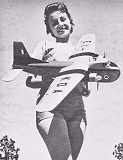 Website visitor Robert C. wrote to
request that I post the article and plans for the
British
Bristol "170" Freighter that appeared in the 1961 Annual edition of American
Modeler magazine. This control line version has a 40" wingspan and is powered
by a pair of .049s for scale-like flight characteristics or a pair .09s if you want
aerobatics. Diesels are shown installed in the original. The fuselage, wing, and
tails surfaces are all built-up and sheeted with balsa, so she is a sturdy bird.
As with most of these vintage models that used glow engines, conversion to electric
can be easily made, and lightening of the structure can be safely done since motors
do not create the extreme vibration loads of internal combustion engines. For instance,
the balsa sheeting of the entire wing could be reduced to only the root area at
the fuselage, and then maybe add a stringer or two along the leading edge top area... Website visitor Robert C. wrote to
request that I post the article and plans for the
British
Bristol "170" Freighter that appeared in the 1961 Annual edition of American
Modeler magazine. This control line version has a 40" wingspan and is powered
by a pair of .049s for scale-like flight characteristics or a pair .09s if you want
aerobatics. Diesels are shown installed in the original. The fuselage, wing, and
tails surfaces are all built-up and sheeted with balsa, so she is a sturdy bird.
As with most of these vintage models that used glow engines, conversion to electric
can be easily made, and lightening of the structure can be safely done since motors
do not create the extreme vibration loads of internal combustion engines. For instance,
the balsa sheeting of the entire wing could be reduced to only the root area at
the fuselage, and then maybe add a stringer or two along the leading edge top area...
 "Led by Thales Alenia Space (TAS), the
EuroHAPS consortium features 21 partners across 11 EU countries, including CIRA,
Elettronica and Leonardo from Italy, ONERA and CEA from France, INTA from Spain,
and ESG with TAO from Germany. The programme will seek to develop and demonstrate
three separate yet complementary high-altitude intelligence, surveillance and reconnaissance
(ISR) platforms, including a solar powered airship, a hybrid airship with an aerofoil,
and a stratospheric balloon system. Under development since 2016 at Thales Alenia
Space, Stratobus is the solar powered stratospheric airship at the core of the programme.
According to TAS, its design has been optimised around an airship roughly 140 metres
in length, though EuroHAPS will see the company delivering 'a reduced-scale Stratobus.'
A large solar array powers the vehicle's four electric motors, with Stratobus capable
of operating..." "Led by Thales Alenia Space (TAS), the
EuroHAPS consortium features 21 partners across 11 EU countries, including CIRA,
Elettronica and Leonardo from Italy, ONERA and CEA from France, INTA from Spain,
and ESG with TAO from Germany. The programme will seek to develop and demonstrate
three separate yet complementary high-altitude intelligence, surveillance and reconnaissance
(ISR) platforms, including a solar powered airship, a hybrid airship with an aerofoil,
and a stratospheric balloon system. Under development since 2016 at Thales Alenia
Space, Stratobus is the solar powered stratospheric airship at the core of the programme.
According to TAS, its design has been optimised around an airship roughly 140 metres
in length, though EuroHAPS will see the company delivering 'a reduced-scale Stratobus.'
A large solar array powers the vehicle's four electric motors, with Stratobus capable
of operating..."
 These images were scanned from my 1976 yearbook
for
Southern Senior High School in Harwood, Maryland. Only pages with information
on Seniors is included. Birthdates have been covered over, but everything else remains.
Please let me know if you would like your picture and/or information removed. On
the other hand, if you would like to send additional information for posting or
would like me to send you the full-resolution scan of your page, then please send
me an e-mail at KirtAAR@aol.com . You can also post messages on my
Blog.RFCafe.com
website. A full list of all the names that go with these photos can be found at
the bottom of this page. Having them in text format (versus a photo) will allow
search engines to find your name and associate it with Southern Senior High School.
Oh, and yes, all the photos are in B&W; there are only eight pages with color
in the entire book! These images were scanned from my 1976 yearbook
for
Southern Senior High School in Harwood, Maryland. Only pages with information
on Seniors is included. Birthdates have been covered over, but everything else remains.
Please let me know if you would like your picture and/or information removed. On
the other hand, if you would like to send additional information for posting or
would like me to send you the full-resolution scan of your page, then please send
me an e-mail at KirtAAR@aol.com . You can also post messages on my
Blog.RFCafe.com
website. A full list of all the names that go with these photos can be found at
the bottom of this page. Having them in text format (versus a photo) will allow
search engines to find your name and associate it with Southern Senior High School.
Oh, and yes, all the photos are in B&W; there are only eight pages with color
in the entire book!
 "SpaceX
plans to carry out its first test flight on Monday of
Starship, the most powerful rocket ever built, designed to send astronauts to
the Moon and eventually beyond. The launch is scheduled to take place at 7:00 am
(1200 GMT) from the sprawling Texas base of the private space company owned by billionaire
Elon Musk. Fallback times are scheduled later in the week if Monday's attempt is
postponed. The US space agency NASA has picked the Starship capsule to ferry its
astronauts to the Moon as part of the Artemis III mission, set for late 2025 at
the earliest. Starship consists of a reusable capsule that carries crew and cargo
and the first-stage Super Heavy booster rocket. The 164-foot (50-meter) tall Starship
spacecraft sits atop the 230-foot tall Super Heavy rocket. SpaceX conducted a successful
test-firing of the 33 Raptor engines on the first-stage booster of Starship in February.
The Super Heavy booster was anchored to the ground during the test-firing, called
a static fire, to prevent it from lifting off. The rocket has never flown in its
full configuration, powered by the first stage..." "SpaceX
plans to carry out its first test flight on Monday of
Starship, the most powerful rocket ever built, designed to send astronauts to
the Moon and eventually beyond. The launch is scheduled to take place at 7:00 am
(1200 GMT) from the sprawling Texas base of the private space company owned by billionaire
Elon Musk. Fallback times are scheduled later in the week if Monday's attempt is
postponed. The US space agency NASA has picked the Starship capsule to ferry its
astronauts to the Moon as part of the Artemis III mission, set for late 2025 at
the earliest. Starship consists of a reusable capsule that carries crew and cargo
and the first-stage Super Heavy booster rocket. The 164-foot (50-meter) tall Starship
spacecraft sits atop the 230-foot tall Super Heavy rocket. SpaceX conducted a successful
test-firing of the 33 Raptor engines on the first-stage booster of Starship in February.
The Super Heavy booster was anchored to the ground during the test-firing, called
a static fire, to prevent it from lifting off. The rocket has never flown in its
full configuration, powered by the first stage..."
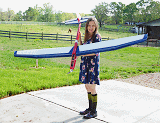 You might have noticed that I have a "thing"
for the Aquila glider. Having built
two - one from plans and one from a kit - back in the mid-1970s when the article
first appeared in RC Modeler magazine, I developed an appreciation for the graceful
lines and the flight performance. In later years I modified a Great Planes 2-Meter
Spirit glider to look a bit like the Aquila, and dubbed it the Aquila Spirit. Next,
never having had a glider with a wingspan greater than 99", I scaled up the Aquila
plans to 105% and built that. That one, which was a lot of work to build, was sold
to a guy in Maryland before making a household move. Now, desiring another Aquila,
I decided to build a version with a one-piece wing, but did not want it to be 99"
long. Two meters was too short, so I went with an 85" wingspan. That is the one
pictured and described here. Because large flying sites are so hard to come by,
I elected to install a motor in the nose, but also provided for a tow hook just
in case. Note the unique method for attaching the wing. I didn't want a removable
cut-out section in the fuselage, so instead the wing passes through the fuselage
and is held fast with a couple small rubber bands. The rubber bands only keep the
wing in alignment. I've never seen anything like it before, so maybe I've just invented
a new method of wing attachment (patent pending)... You might have noticed that I have a "thing"
for the Aquila glider. Having built
two - one from plans and one from a kit - back in the mid-1970s when the article
first appeared in RC Modeler magazine, I developed an appreciation for the graceful
lines and the flight performance. In later years I modified a Great Planes 2-Meter
Spirit glider to look a bit like the Aquila, and dubbed it the Aquila Spirit. Next,
never having had a glider with a wingspan greater than 99", I scaled up the Aquila
plans to 105% and built that. That one, which was a lot of work to build, was sold
to a guy in Maryland before making a household move. Now, desiring another Aquila,
I decided to build a version with a one-piece wing, but did not want it to be 99"
long. Two meters was too short, so I went with an 85" wingspan. That is the one
pictured and described here. Because large flying sites are so hard to come by,
I elected to install a motor in the nose, but also provided for a tow hook just
in case. Note the unique method for attaching the wing. I didn't want a removable
cut-out section in the fuselage, so instead the wing passes through the fuselage
and is held fast with a couple small rubber bands. The rubber bands only keep the
wing in alignment. I've never seen anything like it before, so maybe I've just invented
a new method of wing attachment (patent pending)...
 Bell Telephone Company played an important
role in the development of the aviation industry by providing communications systems
for airlines. As intimated in this promotion in Boys' Life magazine, in 1961, Bell
introduced the
"air-ground-air" radio system, which allowed pilots to communicate directly
with air traffic controllers on the ground, improving safety and efficiency in air
travel. This system was a major technological advancement, as it replaced the earlier
system of communicating via Morse code, which was slow and prone to errors. The
air-ground-air system allowed pilots to communicate in real-time with controllers,
enabling faster and more accurate instructions for takeoff, landing, and navigating
airspace. Bell Telephone Company continued to innovate in the aviation industry,
introducing new technologies such as satellite-based navigation systems and weather
radar systems, which have greatly improved air travel safety and efficiency... Bell Telephone Company played an important
role in the development of the aviation industry by providing communications systems
for airlines. As intimated in this promotion in Boys' Life magazine, in 1961, Bell
introduced the
"air-ground-air" radio system, which allowed pilots to communicate directly
with air traffic controllers on the ground, improving safety and efficiency in air
travel. This system was a major technological advancement, as it replaced the earlier
system of communicating via Morse code, which was slow and prone to errors. The
air-ground-air system allowed pilots to communicate in real-time with controllers,
enabling faster and more accurate instructions for takeoff, landing, and navigating
airspace. Bell Telephone Company continued to innovate in the aviation industry,
introducing new technologies such as satellite-based navigation systems and weather
radar systems, which have greatly improved air travel safety and efficiency...
 The AirplanesAnd The AirplanesAnd
Rockets.com website exists entirely on the support of its visitors by way of a small
percentage earned with your
Amazon.com purchases, which typically works out to less than
$10 per month. That barley covers the domain registration and secure server fees
for AirplanesAndRockets.com. If you plan to buy items via
Amazon.com, please click on this link to begin your shopping
session from here so that I get credit for it. Doing so does not cost you anything
extra. Thank you for your support.
 You
might wonder why an article entitled "Winning
the National Radio Control Meet" for model airplanes would appear in the ARRL's
QST magazine. The answer is that back in 1940 when it was published, a
Ham license was required to operate a radio control (R/C) transmitter. There were
no license-free bands for hobbyists as there are now. In fact, it wasn't until 1976
that the FCC suspended their requirement for registration as an operator, which
has returned in the form of an FAA "drone" (aka USAS) pilot directive. The author,
William E. Good, was the twin brother of Walter A. Good, both of whom held
doctoral degrees in and physics and Ham licenses, and were referred to as "the fathers
of radio control." The photo of Bill shows his station identification (W8IFD) displayed
on the transmitter enclosure, as required by the FCC. They were born in 1916 and
won the R/C championship in 1949, at the age of 33. In the early days, R/C operators
built (and often designed) their systems, including the electronics and mechanics.
They were the pioneers that took the figurative arrows while forging the frontiers
of this hobby. A couple notable items mentioned in the article are the needing a
QSA "5" level signal (the highest quality of reception) in order to assure reliable
control of the aircraft, and of how Hams helped advance the design of small internal
combustion engines. Also, Fig. 4 shows the rudder escapement located in the
vertical fin, with the wound rubber there as well... You
might wonder why an article entitled "Winning
the National Radio Control Meet" for model airplanes would appear in the ARRL's
QST magazine. The answer is that back in 1940 when it was published, a
Ham license was required to operate a radio control (R/C) transmitter. There were
no license-free bands for hobbyists as there are now. In fact, it wasn't until 1976
that the FCC suspended their requirement for registration as an operator, which
has returned in the form of an FAA "drone" (aka USAS) pilot directive. The author,
William E. Good, was the twin brother of Walter A. Good, both of whom held
doctoral degrees in and physics and Ham licenses, and were referred to as "the fathers
of radio control." The photo of Bill shows his station identification (W8IFD) displayed
on the transmitter enclosure, as required by the FCC. They were born in 1916 and
won the R/C championship in 1949, at the age of 33. In the early days, R/C operators
built (and often designed) their systems, including the electronics and mechanics.
They were the pioneers that took the figurative arrows while forging the frontiers
of this hobby. A couple notable items mentioned in the article are the needing a
QSA "5" level signal (the highest quality of reception) in order to assure reliable
control of the aircraft, and of how Hams helped advance the design of small internal
combustion engines. Also, Fig. 4 shows the rudder escapement located in the
vertical fin, with the wound rubber there as well...
 he first-ever appearance of animated Peanuts
characters came in the form of television commercials for the
1960 Ford Falcon. I learned
about them in a book titled Peanuts: The Art of Charles M. Schulz. To me, Peanuts
represents a more innocent time in America, where neighborhood kids played together,
were moral in their actions, and even "crabby" kids like Lucy were not evil. Cops
and robbers, cowboys and Indians, pirates and naval mariners did battle with makeshift
weapons and only one ball team at a time won a trophy. My sisters and I rode in
basic cars like the Ford Falcon, without the benefit of seat belts, crawling up
onto the package shelf in the back to watch the world pass by, standing on our heads
in the back seat, and thinking it a privilege to get to ride up front on the rare
occasions when Mom was not in the car, too. It takes me back to my boyhood days
in the 1960s and 70s when similar activities were a part of life, without all the
computer-based activities... he first-ever appearance of animated Peanuts
characters came in the form of television commercials for the
1960 Ford Falcon. I learned
about them in a book titled Peanuts: The Art of Charles M. Schulz. To me, Peanuts
represents a more innocent time in America, where neighborhood kids played together,
were moral in their actions, and even "crabby" kids like Lucy were not evil. Cops
and robbers, cowboys and Indians, pirates and naval mariners did battle with makeshift
weapons and only one ball team at a time won a trophy. My sisters and I rode in
basic cars like the Ford Falcon, without the benefit of seat belts, crawling up
onto the package shelf in the back to watch the world pass by, standing on our heads
in the back seat, and thinking it a privilege to get to ride up front on the rare
occasions when Mom was not in the car, too. It takes me back to my boyhood days
in the 1960s and 70s when similar activities were a part of life, without all the
computer-based activities...
 Airplanes and Rockets visitor Jochen S.,
a school teacher from Germany, wrote to request that I scan this
Super Sabre Trainer
(SST) article that appeared in the May 1972 edition of American Aircraft Modeler
magazine. The SST reference had marketing gravitas in the day because of the public
fascination with the Supersonic Transport (SST). The Super Sabre Trainer is a ½A
control-line model designed by Dean Swift for his 6-year-old son to learn to build
and fly C/L airplanes. It is a simple, profile fuselage with sheet balsa surfaces.
Jochen wants to use the SST in a program to introduce students to aircraft modeling.
He says they will also benefit from trying to read the article in English and to
convert inches to metric units... Airplanes and Rockets visitor Jochen S.,
a school teacher from Germany, wrote to request that I scan this
Super Sabre Trainer
(SST) article that appeared in the May 1972 edition of American Aircraft Modeler
magazine. The SST reference had marketing gravitas in the day because of the public
fascination with the Supersonic Transport (SST). The Super Sabre Trainer is a ½A
control-line model designed by Dean Swift for his 6-year-old son to learn to build
and fly C/L airplanes. It is a simple, profile fuselage with sheet balsa surfaces.
Jochen wants to use the SST in a program to introduce students to aircraft modeling.
He says they will also benefit from trying to read the article in English and to
convert inches to metric units...
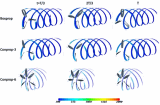 "Electrification is seen as having an important
role to play in the fossil-free aviation of tomorrow. But electric aviation is battling
a dilemma: the more energy-efficient an electric aircraft is, the noisier it gets.
Now, researchers at Chalmers University of Technology, Sweden, have developed a
propeller design optimization method that paves the way for quiet, efficient
electric aviation. In recent years, electrification has been described as having
an important role in reducing emissions from future aviation. Due to the challenges
posed by longer ranges, interest is chiefly focused on electric propeller planes
covering shorter distances. Propellers connected to electric motors are considered
the most efficient propulsion system for regional and domestic flights. But while
the airplanes are electric, propellers cause another kind of emission - noise. The
noise from the propeller blades wouldn't just disturb air passengers. Future electric
aircraft will need to fly at relatively low altitudes, with noise disturbance..." "Electrification is seen as having an important
role to play in the fossil-free aviation of tomorrow. But electric aviation is battling
a dilemma: the more energy-efficient an electric aircraft is, the noisier it gets.
Now, researchers at Chalmers University of Technology, Sweden, have developed a
propeller design optimization method that paves the way for quiet, efficient
electric aviation. In recent years, electrification has been described as having
an important role in reducing emissions from future aviation. Due to the challenges
posed by longer ranges, interest is chiefly focused on electric propeller planes
covering shorter distances. Propellers connected to electric motors are considered
the most efficient propulsion system for regional and domestic flights. But while
the airplanes are electric, propellers cause another kind of emission - noise. The
noise from the propeller blades wouldn't just disturb air passengers. Future electric
aircraft will need to fly at relatively low altitudes, with noise disturbance..."
 Back in the early 1970s when first entering
the realm of radio control, I loved sailplanes because of their graceful appearance.
Gliders were also the only reasonably priced models with long wingspans, so there
was that, too. My first glider was a Sterling Cirrus (87" wingspan), which was not
meant for R/C other than a very compact and lightweight escapement system with a
single channel on rudder. I made the tragic decision to install two servos from
my newly acquired, used OS DP−3, 3-channel radio. It made the model so heavy that
the thin wings could barely support it. About three or four flights did it in. From
there I graduated to a Marks Windward glider, then to the Windfree. My ultimate
experience was with an Airtronics Aquila sailplane with a third channel operating
wing flaps. This Cirrus model by Graupner, with its amazing 118" wingspan and an
ABS molded plastic fuselage was one of the kits that was not within reach of my
meager budget. At the time (c1976) the retail price was somewhere in the $60 range,
which in today's highly inflated dollars is the equivalent of about $285... Back in the early 1970s when first entering
the realm of radio control, I loved sailplanes because of their graceful appearance.
Gliders were also the only reasonably priced models with long wingspans, so there
was that, too. My first glider was a Sterling Cirrus (87" wingspan), which was not
meant for R/C other than a very compact and lightweight escapement system with a
single channel on rudder. I made the tragic decision to install two servos from
my newly acquired, used OS DP−3, 3-channel radio. It made the model so heavy that
the thin wings could barely support it. About three or four flights did it in. From
there I graduated to a Marks Windward glider, then to the Windfree. My ultimate
experience was with an Airtronics Aquila sailplane with a third channel operating
wing flaps. This Cirrus model by Graupner, with its amazing 118" wingspan and an
ABS molded plastic fuselage was one of the kits that was not within reach of my
meager budget. At the time (c1976) the retail price was somewhere in the $60 range,
which in today's highly inflated dollars is the equivalent of about $285...
 There is probably no more extensive a collection
of radio control systems in the world that the one assembled at the
Radio Control Hall of Fame and Museum. It
is located in Cleveland Heights, Ohio. Information on the website about its history
and current efforts appear to be out of date. At the time of the last entry the
About Us page says: "Our 'museum' is just our private collection of equipment and
other artifacts, together with our 'encyclopedia' of radio control, this website,
and other books, literature and documents. The collection (over 1600 transmitters
and many more receivers and actuators) has grown to where it may now be the largest
in the world. The encyclopedia has a chapter for each manufacturer, even many obscure
ones, containing a chronology of advertisements, product reviews, schematics, historic
photos and other documentation..." There is probably no more extensive a collection
of radio control systems in the world that the one assembled at the
Radio Control Hall of Fame and Museum. It
is located in Cleveland Heights, Ohio. Information on the website about its history
and current efforts appear to be out of date. At the time of the last entry the
About Us page says: "Our 'museum' is just our private collection of equipment and
other artifacts, together with our 'encyclopedia' of radio control, this website,
and other books, literature and documents. The collection (over 1600 transmitters
and many more receivers and actuators) has grown to where it may now be the largest
in the world. The encyclopedia has a chapter for each manufacturer, even many obscure
ones, containing a chronology of advertisements, product reviews, schematics, historic
photos and other documentation..."
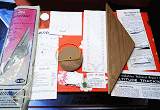 This is the vintage Estes AltiTrak. The
one I had back in the 1970s was made of wood that went by the name
Altiscope (Cat. No. 651−A−1). The
AltiTrak one is a newer incarnation made of plastic and is held like a pistol. Both
models work on the right triangle completion principle. You stand off a predetermined
distance from where you expect the rocket to be at apogee (its high point of flight),
and then follow it up with your instrument. At the highest point, you lock the angle
indicator on the protractor. You can see the concept in the picture to the left
(click for a larger version). The base of the right angle angle is the side adjacent
to the measured angle (θ), which makes the vertical line to the apogee the side
opposite the measured angle. Since the tangent of an angle is equal to the quotient
of the side opposite divided by the side adjacent (which you determined at the beginning),
that leaves the altitude being... This is the vintage Estes AltiTrak. The
one I had back in the 1970s was made of wood that went by the name
Altiscope (Cat. No. 651−A−1). The
AltiTrak one is a newer incarnation made of plastic and is held like a pistol. Both
models work on the right triangle completion principle. You stand off a predetermined
distance from where you expect the rocket to be at apogee (its high point of flight),
and then follow it up with your instrument. At the highest point, you lock the angle
indicator on the protractor. You can see the concept in the picture to the left
(click for a larger version). The base of the right angle angle is the side adjacent
to the measured angle (θ), which makes the vertical line to the apogee the side
opposite the measured angle. Since the tangent of an angle is equal to the quotient
of the side opposite divided by the side adjacent (which you determined at the beginning),
that leaves the altitude being...
 This
poem, including the title,
"Flying High: Ode on a Radio Controlled Model Airplane,"
was generated automatically by ChatGPT based on the following request: "write a
rhyming poem about radio controlled model airplanes." That was it; no other prompting.
There is nothing profound about the prose itself; the profundity is in the capability
of a computer program to take a simple request and then intelligently (artificial
though it may be; i.e., AI) and assimilate all the pertinent information to come
up with every word shown below. ChatGPT created all five verses exactly as shown... This
poem, including the title,
"Flying High: Ode on a Radio Controlled Model Airplane,"
was generated automatically by ChatGPT based on the following request: "write a
rhyming poem about radio controlled model airplanes." That was it; no other prompting.
There is nothing profound about the prose itself; the profundity is in the capability
of a computer program to take a simple request and then intelligently (artificial
though it may be; i.e., AI) and assimilate all the pertinent information to come
up with every word shown below. ChatGPT created all five verses exactly as shown...
 The first thing I learned (or re-learned)
in reading this article is that in 1967, "Hertz" had only recently been assigned
as the official unit of frequency. According to Wikipedia, International Electrotechnical
Commission (IEC) adopted it in in 1930, but it wasn't until 1960 that it was adopted
by the General Conference on Weights and Measures (CGPM) (Conférence Générale des
Poids et Mesures). Hertz replace cycles per second (cps). The next thing that happened
was that I was reminded of how images such as the op-art tracing of
antenna oscillation that are routinely generated today by sophisticated software,
required huge amounts of setup time and trials to yield just a single useful and
meaningful image using actual hardware... The first thing I learned (or re-learned)
in reading this article is that in 1967, "Hertz" had only recently been assigned
as the official unit of frequency. According to Wikipedia, International Electrotechnical
Commission (IEC) adopted it in in 1930, but it wasn't until 1960 that it was adopted
by the General Conference on Weights and Measures (CGPM) (Conférence Générale des
Poids et Mesures). Hertz replace cycles per second (cps). The next thing that happened
was that I was reminded of how images such as the op-art tracing of
antenna oscillation that are routinely generated today by sophisticated software,
required huge amounts of setup time and trials to yield just a single useful and
meaningful image using actual hardware...
 "The
3D-printed Terran 1 rocket from Relativity
Space will fly from Florida's space coast, and will also mark the first natural
liquid natural gas booster in space if all goes to plan. The world's first 3D-printed
rocket may soar to space as soon as March. Relativity Space says it has launch licenses
ready for its expendable, 3D-printed Terran 1 rocket to attempt its orbital debut
on March 8, no earlier than 1 p.m. EST. Company officials confirmed on Twitter Wednesday
that the launch will proceed from Cape Canaveral Space Force Station on Florida's
space coast [March 23rd]. The mission is called GLHF (Good Luck, Have Fun) and will
assure the readiness of the 110-foot Terran 1 before it flies customer payloads..." "The
3D-printed Terran 1 rocket from Relativity
Space will fly from Florida's space coast, and will also mark the first natural
liquid natural gas booster in space if all goes to plan. The world's first 3D-printed
rocket may soar to space as soon as March. Relativity Space says it has launch licenses
ready for its expendable, 3D-printed Terran 1 rocket to attempt its orbital debut
on March 8, no earlier than 1 p.m. EST. Company officials confirmed on Twitter Wednesday
that the launch will proceed from Cape Canaveral Space Force Station on Florida's
space coast [March 23rd]. The mission is called GLHF (Good Luck, Have Fun) and will
assure the readiness of the 110-foot Terran 1 before it flies customer payloads..."
 Humor in the 1930s was a bit different than
it is today. Times were simpler and thought processes were not as complex as in
today's world where information is attacking you every moment of the day. Public
discourse and personal decorum were held to a higher level, so even stinging jokes
and references usually didn't require lowering yourself into the cultural gutter
to comprehend and appreciate. As you read through these "Wisecrack-Ups"
from the May 1934 issue of Flying Aces magazine, some of the quips will
seem corny or downright dumb. Most can be appreciated even by modern humor standards,
and all will be repeatable to any audience regardless of age or gender. An occasional
nod is given to
Lt. Phineas
Pinkham, of the the "turbulent and inimitable Ninth Pursuit Squadron," during
World War I (known simply as "the World War" at the time since #II had not
occurred yet.)... Humor in the 1930s was a bit different than
it is today. Times were simpler and thought processes were not as complex as in
today's world where information is attacking you every moment of the day. Public
discourse and personal decorum were held to a higher level, so even stinging jokes
and references usually didn't require lowering yourself into the cultural gutter
to comprehend and appreciate. As you read through these "Wisecrack-Ups"
from the May 1934 issue of Flying Aces magazine, some of the quips will
seem corny or downright dumb. Most can be appreciated even by modern humor standards,
and all will be repeatable to any audience regardless of age or gender. An occasional
nod is given to
Lt. Phineas
Pinkham, of the the "turbulent and inimitable Ninth Pursuit Squadron," during
World War I (known simply as "the World War" at the time since #II had not
occurred yet.)...
 If you have only ever known a time in the
R/C era when 2.4 GHz, spread spectrum radios were in use and not only were
there no interference issues, but there were no licenses required, either, for legal
operation, then it might be hard to imagine when this was not so. Most people in
the R/C realm at least remember the 72 MHz frequency band where each system
operated on a specific center frequency, where no two systems could be operated
in the same vicinity. Before that there was the 27 MHz band, which is where
I began, more specifically on 27.195 MHz. Only five frequencies were reserved
by the FCC exclusively for radio control use. That meant never more than five planes
in the air, or even being worked on with the radio on, at a time. The band was part
of the original Citizens Band (CB) radio allocation. Commercial CB radios were notoriously
lousy at controlling bandwidth and often overlapped the R/C bands with enough power
to cause deadly (to a model) interference. My FCC operator's permits (Class
C and Class D), obtained sometime around 1972, is long gone... If you have only ever known a time in the
R/C era when 2.4 GHz, spread spectrum radios were in use and not only were
there no interference issues, but there were no licenses required, either, for legal
operation, then it might be hard to imagine when this was not so. Most people in
the R/C realm at least remember the 72 MHz frequency band where each system
operated on a specific center frequency, where no two systems could be operated
in the same vicinity. Before that there was the 27 MHz band, which is where
I began, more specifically on 27.195 MHz. Only five frequencies were reserved
by the FCC exclusively for radio control use. That meant never more than five planes
in the air, or even being worked on with the radio on, at a time. The band was part
of the original Citizens Band (CB) radio allocation. Commercial CB radios were notoriously
lousy at controlling bandwidth and often overlapped the R/C bands with enough power
to cause deadly (to a model) interference. My FCC operator's permits (Class
C and Class D), obtained sometime around 1972, is long gone...
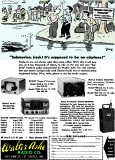 The
Walter Ashe Radio Company, featured in this 1955 issue of Radio & Television
News magazine, was a British radio manufacturer that operated from the 1920s
to the 1950s. The company was founded by Walter Ashe, who was an engineer and inventor.
In the early days, the company produced crystal radios, which were simple radios
that used a piece of crystal to detect radio waves. However, the company quickly
expanded its product range to include valve radios, which were more advanced and
offered better sound quality. During World War II, the company produced radios for
the British armed forces, including the famous "Gibson Girl" portable radio, which
was used by soldiers in the field. After the war, the company continued to produce
radios for the civilian market, including the popular "Waverley" series of radios.
In the 1950s, the company began to face increasing competition from foreign manufacturers,
and it struggled to keep up with the rapidly changing technology in the radio industry... The
Walter Ashe Radio Company, featured in this 1955 issue of Radio & Television
News magazine, was a British radio manufacturer that operated from the 1920s
to the 1950s. The company was founded by Walter Ashe, who was an engineer and inventor.
In the early days, the company produced crystal radios, which were simple radios
that used a piece of crystal to detect radio waves. However, the company quickly
expanded its product range to include valve radios, which were more advanced and
offered better sound quality. During World War II, the company produced radios for
the British armed forces, including the famous "Gibson Girl" portable radio, which
was used by soldiers in the field. After the war, the company continued to produce
radios for the civilian market, including the popular "Waverley" series of radios.
In the 1950s, the company began to face increasing competition from foreign manufacturers,
and it struggled to keep up with the rapidly changing technology in the radio industry...
 The Estes
Saturn V rocket is a model that I really wanted to have as a kid, but never
could justify spending the money. In those days, I launched everything that I built,
so I could not see spending a huge amount of my paper route money only to take the
risk of destruction due to the parachutes not deploying properly or maybe an engine
malfunction. I had launched enough rockets to know that the probability of something
going wrong was directly proportional to the cost and time spent building. Instead,
I stuck mostly with models that cost no more than about $3 (in 1960s-1970s dollars).
The photo to the left is one of my favorites since it shows the Estes Saturn V... The Estes
Saturn V rocket is a model that I really wanted to have as a kid, but never
could justify spending the money. In those days, I launched everything that I built,
so I could not see spending a huge amount of my paper route money only to take the
risk of destruction due to the parachutes not deploying properly or maybe an engine
malfunction. I had launched enough rockets to know that the probability of something
going wrong was directly proportional to the cost and time spent building. Instead,
I stuck mostly with models that cost no more than about $3 (in 1960s-1970s dollars).
The photo to the left is one of my favorites since it shows the Estes Saturn V...
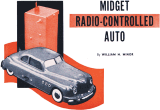 This "Midget Radio-Controlled
Auto" article from a 1952 issue of Radio & Television News magazine
was a major feat of engineering by Mr. William Minor. He designed and built the
car for his 6-year-old son. The amount of electronics and mechanics he crammed into
such a small volume in that R/C car would have qualified him for an engineering
position at a Japanese SLR (single lens reflex) camera company. Although not explicitly
mentioned, operating the car by radio control back in those days required an amateur
radio operator license. Interestingly, he mentions that when choosing a frequency,
he opted for one above the television broadcast channels so as to avoid interference
with nearby TV sets. I've mentioned before how turning on my 27.195 MHz R/C
system I had as a kid in the early 1970's would cause the neighborhood women to
scream at me for messing up their daytime soap operas. Even though nobody would
deign to undertake such an extensive project nowadays, I thought the extreme effort
by Mr. Minor was worth honoring with a posting of his article... This "Midget Radio-Controlled
Auto" article from a 1952 issue of Radio & Television News magazine
was a major feat of engineering by Mr. William Minor. He designed and built the
car for his 6-year-old son. The amount of electronics and mechanics he crammed into
such a small volume in that R/C car would have qualified him for an engineering
position at a Japanese SLR (single lens reflex) camera company. Although not explicitly
mentioned, operating the car by radio control back in those days required an amateur
radio operator license. Interestingly, he mentions that when choosing a frequency,
he opted for one above the television broadcast channels so as to avoid interference
with nearby TV sets. I've mentioned before how turning on my 27.195 MHz R/C
system I had as a kid in the early 1970's would cause the neighborhood women to
scream at me for messing up their daytime soap operas. Even though nobody would
deign to undertake such an extensive project nowadays, I thought the extreme effort
by Mr. Minor was worth honoring with a posting of his article...
 I never built an
Honest John rocket model when
I was a kid, and to this day still do not own one. The vintage kits on eBay are
through-the-roof expensive. I always liked the unique design and the look of the
nose cone where it bulges out a bit from the diameter of the main body tube. Both
Estes and Centuri made versions of the Honest John. Intentionally or not, there
was an advertisement for the Centuri Honest John model on the page opposite of the
past part of the article in this September 1968 edition of American Aircraft Modeler
magazine, from which this page was scanned. The Honest John M-31 artillery rocket
was a surface-to-surface rocket that was developed by the United States Army during
the Cold War era. It was named after President John F. Kennedy's campaign pledge
to be an "honest" president... I never built an
Honest John rocket model when
I was a kid, and to this day still do not own one. The vintage kits on eBay are
through-the-roof expensive. I always liked the unique design and the look of the
nose cone where it bulges out a bit from the diameter of the main body tube. Both
Estes and Centuri made versions of the Honest John. Intentionally or not, there
was an advertisement for the Centuri Honest John model on the page opposite of the
past part of the article in this September 1968 edition of American Aircraft Modeler
magazine, from which this page was scanned. The Honest John M-31 artillery rocket
was a surface-to-surface rocket that was developed by the United States Army during
the Cold War era. It was named after President John F. Kennedy's campaign pledge
to be an "honest" president...
 Believe it or not, there was a day when
building your own electronics was a good way to save money if your budget was smaller
than your appetite for R/C systems, radios, even TV sets. Heathkit comes to mind
for all us old-timers as a source of pre-kitted products, but like most electronics
companies of yore, they no longer offer kits; it is much cheaper to have complete
systems built overseas. Besides, modern components - resistors, capacitors, ICs,
etc., are far too small for most people to work with successfully. Here is a two-part
article from the April and May 1972 editions of American Aircraft Modeler
magazine showing how it was done with a custom 2-channel digital proportional radio
control system dubbed the
AAM Commander. It
still makes a good read because of the theory of operation that is covered... Believe it or not, there was a day when
building your own electronics was a good way to save money if your budget was smaller
than your appetite for R/C systems, radios, even TV sets. Heathkit comes to mind
for all us old-timers as a source of pre-kitted products, but like most electronics
companies of yore, they no longer offer kits; it is much cheaper to have complete
systems built overseas. Besides, modern components - resistors, capacitors, ICs,
etc., are far too small for most people to work with successfully. Here is a two-part
article from the April and May 1972 editions of American Aircraft Modeler
magazine showing how it was done with a custom 2-channel digital proportional radio
control system dubbed the
AAM Commander. It
still makes a good read because of the theory of operation that is covered...
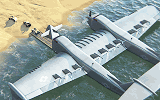 "Two teams - General Atomics working with
Maritime Applied Physics Corporation and Aurora Flight Sciences working with Gibbs &
Cox and ReconCraft - will develop designs for DARPA's
Liberty Lifter Seaplane Wing-in-Ground
Effect full-scale demonstrator. The Liberty Lifter program aims to demonstrate
a leap-ahead in operational capability by designing, building, floating, and flying
a long-range, low-cost X−Plane capable of seaborne strategic and tactical heavy
lift. The planned Liberty Lifter demonstrator will be a large flying boat similar
in size and capacity to the C−17 Globemaster III transport aircraft. Goals include
takeoff and land in Sea State 4, sustained on−water operation up to Sea State 5,
and extended flight close to the water in ground effect with the capability to fly
out of ground effect at altitudes up to 10,000 feet above sea level..." "Two teams - General Atomics working with
Maritime Applied Physics Corporation and Aurora Flight Sciences working with Gibbs &
Cox and ReconCraft - will develop designs for DARPA's
Liberty Lifter Seaplane Wing-in-Ground
Effect full-scale demonstrator. The Liberty Lifter program aims to demonstrate
a leap-ahead in operational capability by designing, building, floating, and flying
a long-range, low-cost X−Plane capable of seaborne strategic and tactical heavy
lift. The planned Liberty Lifter demonstrator will be a large flying boat similar
in size and capacity to the C−17 Globemaster III transport aircraft. Goals include
takeoff and land in Sea State 4, sustained on−water operation up to Sea State 5,
and extended flight close to the water in ground effect with the capability to fly
out of ground effect at altitudes up to 10,000 feet above sea level..."
 The Jetco Shark 15 was my very first
built up control line airplane. Before that they had all been plastic Cox models.
As did many kids in the 1960's and 1970's I learned to fly on a Cox PT−19 Trainer
(summer of 1969, about the time Apollo 11 landed on the moon). Before building
the Shark 15, my experience with built-up models was with rubber-powered free
flight. Mustering enough money for a Shark 15, a Fox 15 C/L engine, and
covering materials was not easy in those days. The Shark 15 flew very nicely
when I could get the Fox 15 started and running properly. Loops, wingovers,
and inverted flight were much more satisfying than with the Cox models, whose .049
engines had a nasty habit of quitting during inverted flight. I resolved to someday
step up to a
Shark 45 once I had enough spare cash, but to this day I still have never
owned one. The largest engine I've ever had on a C/L model was a Fox 35 (equally
temperamental and frustrating) on a Sterling Ringmaster... The Jetco Shark 15 was my very first
built up control line airplane. Before that they had all been plastic Cox models.
As did many kids in the 1960's and 1970's I learned to fly on a Cox PT−19 Trainer
(summer of 1969, about the time Apollo 11 landed on the moon). Before building
the Shark 15, my experience with built-up models was with rubber-powered free
flight. Mustering enough money for a Shark 15, a Fox 15 C/L engine, and
covering materials was not easy in those days. The Shark 15 flew very nicely
when I could get the Fox 15 started and running properly. Loops, wingovers,
and inverted flight were much more satisfying than with the Cox models, whose .049
engines had a nasty habit of quitting during inverted flight. I resolved to someday
step up to a
Shark 45 once I had enough spare cash, but to this day I still have never
owned one. The largest engine I've ever had on a C/L model was a Fox 35 (equally
temperamental and frustrating) on a Sterling Ringmaster...
 Following an extensive seven-month analysis
of data collected from the Aug. 11, 2011, second flight of
DARPA's Hypersonic
Technology Vehicle (HTV-2), an independent engineering review board (ERB) investigating
the cause of a flight anomaly completed its report. The findings of the ERB validated
the vehicle's aerodynamic design and uncovered new information regarding the thermal
material properties of the vehicle. "The greatest achievement from Flight Two, which
the ERB's findings underscored, was that we successfully incorporated aerodynamic
knowledge gained from the first flight into the second flight," said Air Force Maj.
Chris Schulz, DARPA program manager, who holds a doctorate in aerospace engineering.
A technology demonstration and data-gathering platform, the HTV-2's second test
flight was conducted to validate current models and increase technical understanding
of the hypersonic regime... Following an extensive seven-month analysis
of data collected from the Aug. 11, 2011, second flight of
DARPA's Hypersonic
Technology Vehicle (HTV-2), an independent engineering review board (ERB) investigating
the cause of a flight anomaly completed its report. The findings of the ERB validated
the vehicle's aerodynamic design and uncovered new information regarding the thermal
material properties of the vehicle. "The greatest achievement from Flight Two, which
the ERB's findings underscored, was that we successfully incorporated aerodynamic
knowledge gained from the first flight into the second flight," said Air Force Maj.
Chris Schulz, DARPA program manager, who holds a doctorate in aerospace engineering.
A technology demonstration and data-gathering platform, the HTV-2's second test
flight was conducted to validate current models and increase technical understanding
of the hypersonic regime...
 The topic of
R/C system reliability rarely is mentioned in model airplane magazines these
days. Many of the high-end, big dollar planes like jets (turbines), giant scale
and giant 3D, do use redundant receivers and batteries because the pilots have thousands
of dollars worth of equipment and hundreds of hours of personal time invested in
them. Operating at 2.4 GHz with spread spectrum modulation, there is little
to no chance of radio interference, which was a huge problem back when this article
appeared in a 1955 issue of Popular Electronics magazine. William ("Bill")
Winter, who would later serve as president of the Academy of Model aeronautics (AMA),
was editor of Model Airplane News magazine at the time. Vacuum tube receivers
and electromechanical escapements and relays were being used in model airplanes.
The very nature of construction of those components made them extremely vulnerable
to vibration and shock induced intermittent or total failures. The models themselves
were necessarily large and often underpowered for carrying such heavy loads aloft.
We owe the R/C pioneers a lot for taking the arrows of trial and error to ultimately
give us the carefree systems we enjoy today... The topic of
R/C system reliability rarely is mentioned in model airplane magazines these
days. Many of the high-end, big dollar planes like jets (turbines), giant scale
and giant 3D, do use redundant receivers and batteries because the pilots have thousands
of dollars worth of equipment and hundreds of hours of personal time invested in
them. Operating at 2.4 GHz with spread spectrum modulation, there is little
to no chance of radio interference, which was a huge problem back when this article
appeared in a 1955 issue of Popular Electronics magazine. William ("Bill")
Winter, who would later serve as president of the Academy of Model aeronautics (AMA),
was editor of Model Airplane News magazine at the time. Vacuum tube receivers
and electromechanical escapements and relays were being used in model airplanes.
The very nature of construction of those components made them extremely vulnerable
to vibration and shock induced intermittent or total failures. The models themselves
were necessarily large and often underpowered for carrying such heavy loads aloft.
We owe the R/C pioneers a lot for taking the arrows of trial and error to ultimately
give us the carefree systems we enjoy today...
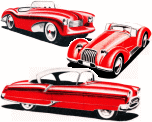 Straight out of Happy Days and American
Graffiti are these reader-submitted
car designs
from Air Trails - Hobbies for Young Men magazine in the year 1954. In 2023
dollars, the $50, $25, and $10 monthly prizes are worth $556, $278, and $111, respectively
(per the BLS Inflation Calculator). That was a lot of dough. About the only requirement
placed on designs was that the auto designs be realistic based on current technology
- no anti-gravity floaters or rocket powered roadsters. All classifications were
allowed - military vehicles, hot rods, family sedans, station wagons, etc., etc... Straight out of Happy Days and American
Graffiti are these reader-submitted
car designs
from Air Trails - Hobbies for Young Men magazine in the year 1954. In 2023
dollars, the $50, $25, and $10 monthly prizes are worth $556, $278, and $111, respectively
(per the BLS Inflation Calculator). That was a lot of dough. About the only requirement
placed on designs was that the auto designs be realistic based on current technology
- no anti-gravity floaters or rocket powered roadsters. All classifications were
allowed - military vehicles, hot rods, family sedans, station wagons, etc., etc...
 "The Defense Advanced Research Projects
Agency has taken a major step forward toward creating an experimental airplane that
can be
maneuvered without traditional ailerons or other mechanical devices, instead
using short bursts of air. DARPA announced Tuesday it had selected Aurora Flight
Sciences to start detailed design of an aircraft that uses a technology called active
flow control to direct it, as part of the Control of Revolutionary Aircraft with
Novel Effectors, or CRANE, program. Aurora is a subsidiary of Boeing headquartered
in Manassas, Virginia, that specializes in developing advanced innovative designs
for aircraft and uncrewed systems. 'Over the past several decades, the active flow
control community has made significant advancements that enable the integration
of active flow control technologies into advanced aircraft..." "The Defense Advanced Research Projects
Agency has taken a major step forward toward creating an experimental airplane that
can be
maneuvered without traditional ailerons or other mechanical devices, instead
using short bursts of air. DARPA announced Tuesday it had selected Aurora Flight
Sciences to start detailed design of an aircraft that uses a technology called active
flow control to direct it, as part of the Control of Revolutionary Aircraft with
Novel Effectors, or CRANE, program. Aurora is a subsidiary of Boeing headquartered
in Manassas, Virginia, that specializes in developing advanced innovative designs
for aircraft and uncrewed systems. 'Over the past several decades, the active flow
control community has made significant advancements that enable the integration
of active flow control technologies into advanced aircraft..."
 Re-timing, cleaning up (air and fuel flow
passages), freeing up (sliding friction), lightening and balancing (removing unnecessary
material), and breaking in (initial running with rich fuel mixture while interfacing
metal parts fit themselves to each other) are all part of the effort necessary to
create winning engines for model racing events. This 1962 American Modeler
magazine article predates Schnuerle porting (in model engines), ABC (aluminum, brass,
chromium) cylinder liners, and modern metal alloys, but still the concepts are applicable
to today's engines. It purpose is to instruct on proper
engine break-in so that
it will have a long lifespan. Wankel lovers will appreciate the homemade engine
shown... Re-timing, cleaning up (air and fuel flow
passages), freeing up (sliding friction), lightening and balancing (removing unnecessary
material), and breaking in (initial running with rich fuel mixture while interfacing
metal parts fit themselves to each other) are all part of the effort necessary to
create winning engines for model racing events. This 1962 American Modeler
magazine article predates Schnuerle porting (in model engines), ABC (aluminum, brass,
chromium) cylinder liners, and modern metal alloys, but still the concepts are applicable
to today's engines. It purpose is to instruct on proper
engine break-in so that
it will have a long lifespan. Wankel lovers will appreciate the homemade engine
shown...
 This article was scanned from the 1961
American Modeler Annual edition. The magazine has been out of print for
decades, and is difficult to access unless you are fortunate enough to buy one off
of e-Bay. Hopefully the original authors won't mind my reprinting "Secrets of 'Winning' Airfoils" here, but if they
do, I will remove it. Airfoil plotting goes back to the NACA (National Advisory
Committee for Aeronautics) days of white shirts, neck ties, thick−rimmed glasses,
and slide rules. Drawing boards, straight edges, and French curves which were in
use since the days of the Wright Brothers eventually got replaced by software, but
all the pioneering work was done by engineers with shirt cuffs smudged with pencil
lead. Consider this a window for a look back in history... This article was scanned from the 1961
American Modeler Annual edition. The magazine has been out of print for
decades, and is difficult to access unless you are fortunate enough to buy one off
of e-Bay. Hopefully the original authors won't mind my reprinting "Secrets of 'Winning' Airfoils" here, but if they
do, I will remove it. Airfoil plotting goes back to the NACA (National Advisory
Committee for Aeronautics) days of white shirts, neck ties, thick−rimmed glasses,
and slide rules. Drawing boards, straight edges, and French curves which were in
use since the days of the Wright Brothers eventually got replaced by software, but
all the pioneering work was done by engineers with shirt cuffs smudged with pencil
lead. Consider this a window for a look back in history...
 "Birds fly more efficiently by folding their
wings during the upstroke, according to a recent study led by Lund University in
Sweden. The results could mean that wing−folding is the next step in increasing
the propulsive and aerodynamic efficiency of flapping drones. Even the precursors
to birds - extinct bird-like dinosaurs - benefited from
folding their wings during the upstroke, as they developed active flight. Among
flying animals alive today, birds are the largest and most efficient. This makes
them particularly interesting as inspiration for the development of drones. However,
determining which flapping strategy is best requires aerodynamic studies of various
ways of flapping the wings. Therefore, a Swedish-Swiss research team has constructed
a robotic wing that can achieve just that - flapping like a bird, and beyond. 'We
have built a robot wing that can flap..." "Birds fly more efficiently by folding their
wings during the upstroke, according to a recent study led by Lund University in
Sweden. The results could mean that wing−folding is the next step in increasing
the propulsive and aerodynamic efficiency of flapping drones. Even the precursors
to birds - extinct bird-like dinosaurs - benefited from
folding their wings during the upstroke, as they developed active flight. Among
flying animals alive today, birds are the largest and most efficient. This makes
them particularly interesting as inspiration for the development of drones. However,
determining which flapping strategy is best requires aerodynamic studies of various
ways of flapping the wings. Therefore, a Swedish-Swiss research team has constructed
a robotic wing that can achieve just that - flapping like a bird, and beyond. 'We
have built a robot wing that can flap..."
 Although originally designed and built for
free flight, this fairly large scale mode of the
Bristol
Scout monoplane could easily be adapted for control line or radio control flying.
With a wingspan of 46 inches and a robust airframe, it can withstand the rigors
of aerobatic flight. Replacing the glow fuel engine with a modern brushless motor
and LiPo batteries helps keep the vibration and therefore wear and tear to a minimum,
and also avoids getting messy fuel all over your nice airplane. It would also allow
you to lighten the airframe a bit to reduce the wing loading. Seeing the younger
boy looking in awe at the airplane reminds me of how I would have regarded it at
that age if given the opportunity even to hold it. Since these plans are no longer
available, you can click the one presented below to get the full resolution version.
It was only one page wide, so it is a bit fuzzy... Although originally designed and built for
free flight, this fairly large scale mode of the
Bristol
Scout monoplane could easily be adapted for control line or radio control flying.
With a wingspan of 46 inches and a robust airframe, it can withstand the rigors
of aerobatic flight. Replacing the glow fuel engine with a modern brushless motor
and LiPo batteries helps keep the vibration and therefore wear and tear to a minimum,
and also avoids getting messy fuel all over your nice airplane. It would also allow
you to lighten the airframe a bit to reduce the wing loading. Seeing the younger
boy looking in awe at the airplane reminds me of how I would have regarded it at
that age if given the opportunity even to hold it. Since these plans are no longer
available, you can click the one presented below to get the full resolution version.
It was only one page wide, so it is a bit fuzzy...
 Melanie and I have been trying to recall
toys and games we had as kids and then searching for them on eBay to see what is
available. If the price isn't too outrageous, we go ahead and by them. Melanie remembered
having a battery-powered
electromechanical toy dachshund that had a hand-held controller (not much in
the way of radio control back in the 1960s). She finally managed to find one, so
we bid on it and got it for a decent price (I don't recall exactly how much, but
around $30 + shipping). It was advertised as not working, but I figured how hard
can it be to fix something that simple? The dog, controller, and box looked to be
be in excellent condition for its age (manufactured in the later 1950's from what
I can find). The problem ended up being that a wire had broken off the motor. A
little solder fixed that, and now it works as good as new. While apart for repair,
I saw that the front and rear body halves are connected with a large spring, and
the wheels and motor a on a freely rotating... Melanie and I have been trying to recall
toys and games we had as kids and then searching for them on eBay to see what is
available. If the price isn't too outrageous, we go ahead and by them. Melanie remembered
having a battery-powered
electromechanical toy dachshund that had a hand-held controller (not much in
the way of radio control back in the 1960s). She finally managed to find one, so
we bid on it and got it for a decent price (I don't recall exactly how much, but
around $30 + shipping). It was advertised as not working, but I figured how hard
can it be to fix something that simple? The dog, controller, and box looked to be
be in excellent condition for its age (manufactured in the later 1950's from what
I can find). The problem ended up being that a wire had broken off the motor. A
little solder fixed that, and now it works as good as new. While apart for repair,
I saw that the front and rear body halves are connected with a large spring, and
the wheels and motor a on a freely rotating...
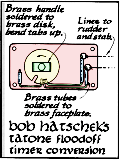 Materials and methods for free flight aeromodeling
have changed significantly since this "Free
Flight Action" column appeared in the January 1975 issue of American Aircraft
Modeler magazine, but the enthusiasm has not. Carbon fiber tubing now constitutes
a large portion of modern free flight duration model airframes, electronic timers
have replaced mechanical wind-up timers (and even dethermalizer fuses), electric
motors have joined (but not replaced) glow fuel engines, and lighter and stronger
covering has supplanted tissue and/or silkspan and dope. More efficient airfoils,
and wing, empennage, and fuselage planforms combine to produce new record flights
in all competitive classes. Even modern weather detection and forecasting is being
used to predict the best moment for launching. You've come a long way, baby... Materials and methods for free flight aeromodeling
have changed significantly since this "Free
Flight Action" column appeared in the January 1975 issue of American Aircraft
Modeler magazine, but the enthusiasm has not. Carbon fiber tubing now constitutes
a large portion of modern free flight duration model airframes, electronic timers
have replaced mechanical wind-up timers (and even dethermalizer fuses), electric
motors have joined (but not replaced) glow fuel engines, and lighter and stronger
covering has supplanted tissue and/or silkspan and dope. More efficient airfoils,
and wing, empennage, and fuselage planforms combine to produce new record flights
in all competitive classes. Even modern weather detection and forecasting is being
used to predict the best moment for launching. You've come a long way, baby...
 Why go to
the trouble and expense when you can get away with floating a cheap
balloon over all North America? "In the sky over southwest China, a team of
researchers has been testing a new wing design that they said could help unmanned
aircraft better
evade radar. The drone, which has no tail, appears to be a scaled-down version
of the United States Air Force's B2 Spirit bomber, and can fly without the use of
elevators, ailerons or flaps - the hinged moving parts known as elevons that help
control flight direction - according to the researchers. 'Our work is a first,'
the team from the China Aerodynamics Research and Development Centre in Sichuan
province said in a paper published on January 19 in the peer-reviewed journal Acta
Aeronautica et Astronautica Sinica..." Why go to
the trouble and expense when you can get away with floating a cheap
balloon over all North America? "In the sky over southwest China, a team of
researchers has been testing a new wing design that they said could help unmanned
aircraft better
evade radar. The drone, which has no tail, appears to be a scaled-down version
of the United States Air Force's B2 Spirit bomber, and can fly without the use of
elevators, ailerons or flaps - the hinged moving parts known as elevons that help
control flight direction - according to the researchers. 'Our work is a first,'
the team from the China Aerodynamics Research and Development Centre in Sichuan
province said in a paper published on January 19 in the peer-reviewed journal Acta
Aeronautica et Astronautica Sinica..."
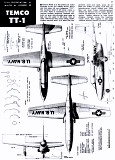 Walter M. Jefferies, Jr., was one of the
premier illustrators for model aircraft magazines in the era that this 4-view drawing
of the Temco TT−1
"Pinto" jet appeared in American Modeler magazine. The Pinto was designed to
be a rugged military trainer. Temco (Texas Engineering & Manufacturing Company
) was in competition with Cessna Aircraft's T−37 "Tweet" ( an embarrassing name)
which we all know by now based on its familiarity won the bid. Once you have heard
the loud, extremely high pitched sound of the T−37 sitting on the tarmac, you'll
never forget it. A primary difference between the two airplanes is that the Pinto
was a tandem seating arrangement, while the Tweet was side-by-side. I would have
given a month's pay when I was in the USAF to be able to get a ride in a T−37. Of
course month's pay for a non-NCO airman back in the 1970's was a pittance, so it
would have been a cheap ride... Walter M. Jefferies, Jr., was one of the
premier illustrators for model aircraft magazines in the era that this 4-view drawing
of the Temco TT−1
"Pinto" jet appeared in American Modeler magazine. The Pinto was designed to
be a rugged military trainer. Temco (Texas Engineering & Manufacturing Company
) was in competition with Cessna Aircraft's T−37 "Tweet" ( an embarrassing name)
which we all know by now based on its familiarity won the bid. Once you have heard
the loud, extremely high pitched sound of the T−37 sitting on the tarmac, you'll
never forget it. A primary difference between the two airplanes is that the Pinto
was a tandem seating arrangement, while the Tweet was side-by-side. I would have
given a month's pay when I was in the USAF to be able to get a ride in a T−37. Of
course month's pay for a non-NCO airman back in the 1970's was a pittance, so it
would have been a cheap ride...
 "EPFL researchers have developed a method
that allows a
flapping-wing
robot to land autonomously on a horizontal perch using a claw-like mechanism.
The innovation could significantly expand the scope of robot-assisted tasks. A bird
landing on a branch makes the maneuver look like the easiest thing in the world,
but in fact, the act of perching involves an extremely delicate balance of timing,
high-impact forces, speed, and precision. It's a move so complex that no flapping-wing
robot (ornithopter) has been able to master it, until now. Raphael Zufferey, a postdoctoral
fellow in the Laboratory of Intelligent Systems (LIS) and Biorobotics ab (BioRob)
in the School of Engineering, is the first author on a recent Nature Communications
paper describing the unique landing gear that makes such perching possible..." "EPFL researchers have developed a method
that allows a
flapping-wing
robot to land autonomously on a horizontal perch using a claw-like mechanism.
The innovation could significantly expand the scope of robot-assisted tasks. A bird
landing on a branch makes the maneuver look like the easiest thing in the world,
but in fact, the act of perching involves an extremely delicate balance of timing,
high-impact forces, speed, and precision. It's a move so complex that no flapping-wing
robot (ornithopter) has been able to master it, until now. Raphael Zufferey, a postdoctoral
fellow in the Laboratory of Intelligent Systems (LIS) and Biorobotics ab (BioRob)
in the School of Engineering, is the first author on a recent Nature Communications
paper describing the unique landing gear that makes such perching possible..."
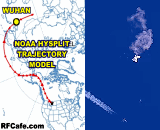 As of September 16, 2022,
if I fly my radio-controlled model airplane, helicopter, or drone even an inch off
the ground anywhere in the U.S. without having a specially designed and certified
electronics device - at my expense - broadcasting identification and position data
("Remote
ID of Unmanned Aircraft"), I can be fined and/or jailed and/or have my equipment
confiscated by the U.S. government. The stated justification is concern for safety
of property, persons, and national security. However, if a country established as
a military and economic threat to the U.S. flies a huge uncontrolled (other than
by altitude in air currents) aircraft burdened by maybe 1000 pounds of equipment,
including batteries, from coast to coast across populated areas, no action is taken.
Here is a video of the Chinese balloon finally
being shot down over the ocean after it was allowed to collect and relay data,
and even possibly release pathogens over wide areas for days (NOAA
HYSPLIT trajectory). Here's Trump impersonator
Shawn F.
with his take on the Chinese spy balloon debacle. Another victory for China! As of September 16, 2022,
if I fly my radio-controlled model airplane, helicopter, or drone even an inch off
the ground anywhere in the U.S. without having a specially designed and certified
electronics device - at my expense - broadcasting identification and position data
("Remote
ID of Unmanned Aircraft"), I can be fined and/or jailed and/or have my equipment
confiscated by the U.S. government. The stated justification is concern for safety
of property, persons, and national security. However, if a country established as
a military and economic threat to the U.S. flies a huge uncontrolled (other than
by altitude in air currents) aircraft burdened by maybe 1000 pounds of equipment,
including batteries, from coast to coast across populated areas, no action is taken.
Here is a video of the Chinese balloon finally
being shot down over the ocean after it was allowed to collect and relay data,
and even possibly release pathogens over wide areas for days (NOAA
HYSPLIT trajectory). Here's Trump impersonator
Shawn F.
with his take on the Chinese spy balloon debacle. Another victory for China!
|


